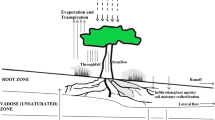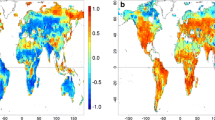Abstract
HDS-SPAC, a new soil-plant-atmosphere continuum (SPAC) model, is developed for simulating water and heat transfer in SPAC. The model adopts a recently proposed hybrid dual source approach for soil evaporation and plant transpiration partitioning. For the above-ground part, a layer approach is used to partition available energy and calculate aerodynamic resistances, while a patch approach is used to derive sensible heat and latent heat fluxes from the two sources (soil and vegetation). For the below-ground part, soil water and heat dynamics are described by the mixed form of Richards equation, and the soil heat conductivity equation, respectively. These two parts are coupled through ground heat flux for energy transfer, root-zone water potential-dependent stomatal resistance, and surface soil water potential-dependent evaporation for water transfer. Evaporation is calculated from the water potential gradient at soil-atmosphere interface and aerodynamic resistance, and transpiration is determined using a Jarvis-type function linking soil water availability and atmospheric conditions. Some other processes, such as canopy interception and deep percolation, are also considered in the HDS-SPAC model. The hybrid dual-source approach allows HDS-SPAC to simulate heat and water transfer in an ecosystem with a large range of vegetation cover change temporally or spatially. The model was tested with observations at a wheat field in North China Plain over a time of three months covering both wet and dry conditions. The fractional crop covers change from 30% to over 90%. The results indicated that the HDS-SPAC model can estimate actual evaporation and transpiration partitioning and soil water content and temperature over the whole range of tested vegetation coverage.
Similar content being viewed by others
References
Wilson T B, Norman J M, Bland, et al. Evaluation of the importance of Lagrangian canopy turbulence formulations in a soil-plant-atmosphere model. Agric Forest Meteorol, 2003, 115: 51–69
Lee Y H, Mahrt L. Comparison of heat and moisture fluxes from a modified soil-plant-atmosphere model with observations from BOREAS. J Geophys Res, 2004, 109: D08103.1-D08103.9
Lei H M, Yang D W, Stanislaus J, et al. Modeling the crop transpiration using an optimality-based approach. Sci China Ser E-Tech Sci, 2008, 51: 60–75
Krobel R, Sun Q P, Ingwersen J, et al. Modelling water dynamics with DNDC and DAISY in a soil of the North China Plain: A comparative study. Environ Modell Softw, 2010, 25: 583–598
Monteith J L. Evaporation and environment. Symp Soc Exp Biol, 1965, 19: 205–234
Kustas W P, Norman J M. Evaluation of soil and vegetation heat flux predictions using a simple two-source model with radiometric temperatures for partial canopy cover. Agric Forest Meteorol, 1999, 94: 13–29
Sánchez J M, Kustas W P, Caselles V, et al. Modeling surface energy fluxes over maize using a two-source patch model and radiometric soil and canopy temperature observations. Remote Sens Environ, 2008, 112: 1130–1143
Zhang B Z, Kang S Z, Zhang L, et al. An evapotranspiration model for sparsely vegetated canopies under partial root-zone irrigation. Agric For Meteorol, 2009, 149: 2007–2011
Lhomme J P, Chehbouni A. Comments on dual-source vegetation-atmosphere transfer models. Agric Forest Meteorol, 1999, 94: 269–273
Shuttleworth W J, Wallace J S. Evaporation from sparse crops-an energy combination theory. Quart J Met Soc, 1985, 111: 839–855
Kustas W P, Norman J M. A two-source approach for estimating turbulent fluxes using multiple angle thermal infrared observations. Water Resour Res, 1997, 33: 1495–1508
Norman J M, Kustas W P, Humes K S. Source approach for estimating soil and vegetation energy fluxes in observations of directional radiometric surface temperature. Agric Forest Meteorol, 1995, 77: 263–293
Guan H D. Water above the mountain front—assessing mountain-block recharge in semiarid regions. Dissertation of Doctoral Degree. Socorro: New Mexico Institute of Mining and Technology, 2005. 85–111
Timmermans W J, Kustas W P, Anderson M C, et al. An intercomparison of the Surface Energy Balance Algorithm for Land (SEBAL) and the Two-Source Energy Balance (TSEB) modeling schemes. Remote Sens Environ, 2007, 108: 369–384
Braud I, Dantas-Antonino A C, Vauclin M, et al. A simple soil-plant-atmosphere transfer model (SiSPAT) development and field verification. J Hydrol, 1995, 166: 213–250
Lee Y H, Park S U. Evaluation of a modified soil-plant-atmosphere model for CO2 flux and latent heat flux in open canopies. Agric Forest Meteorol, 2007, 143: 230–241
Zhang L, Dawes W R, Hatton T J. Modelling hydrologic processes using a biophysically based model—application of WAVES to FIFE and HAPEX-MOBILHY. J Hydrol, 1996, 185: 147–169
Walko R L, Band L E, Baron J, et al. Coupled atmosphere-biophysics-hydrology models for environmental modeling. J Appl Meteorol, 2000, 39: 931–944
Guan H D, Wilson J L. A hybrid dual-source model for potential evaporation and transpiration partitioning. J Hydrol, 2009, 377: 405–416
Miao H X, Chen S P, Chen J Q, et al. Cultivation and grazing altered evapotranspiration and dynamics in Inner Mongolia steppes. Agric Forest Meteorol, 2009, 149: 1810–1819
Tognetti R, Giovannelli A, Lavini A, et al. Assessing environmental controls over conductances through the soil-plant-atmosphere continuum in an experimental olive tree plantation of southern Italy. Agric Forest Meteorol, 2009, 149: 1229–1243
Yamanaka T, Takeda A, Shimada J. Evaporation beneath the soil surface: some observational evidence and numerical experiments. Hydrol Process, 1998, 12: 2193–2203
Seneviratne S I, Corti T, Davin E L, et al. Investigating soil moisture-climate interactions in a changing climate: A review. Earth Sci Rev, 2010, 99: 125–161
Campbell G S, Norman J M. An Introduction to Environmental Biophysics. New York: Springer, 1998. 63–110
Allen R G, Pereira L S, Raes D, et al. Crop evapotranspiration: Guidelines for computing crop water requirements. FAO Irrigation and Drainage Paper 56. Rome: FAO, 1998. 41–53
Lin J D, Sun S F. A study of moisture and heat transport in soil and the effect of resistance to evaporation (in Chinese). J Hydraul Eng, 1983, 14: 1–8
Edlefson N E, Anderson A B C. Thermodynamics of soil moisture. Hilgardia, 1943, 15: 31–298
Deardorff J W. Efficient prediction of ground surface temperature and moisture with inclusion of a layer of vegetation. J Geophys Res, 1978, 20: 1889–1903
Noilhan J, Planton S. A simple parameterization of land surface processes for meteorological models. Mon Weather Rev, 1989, 117: 536–549
Taconet O, Bernard R, Vidal-Madjar D. Evapotranspiration over an agricultural region using a surface flux/temperature model based on NOAA-AVHRR data. J Clim Appl Meteorol, 1986, 25: 284–307
Monteith J L. Principles of Environmental Physics. London: Edward Arnold, 1973. 1–291
Choudhury B J, Monteith J L. A four-layer model for the heatbudget of homogeneous land surfaces. Q J R Meteorol Soc, 1988, 114: 373–398
Chen J M, Liu J, Cihlar J, et al. Daily canopy photosynthesis model through temporal and spatial scaling for remote sensing applications. Ecol Modell, 1999, 124: 99–119
Bond B J, Meinzer F C, Brooks J R. How trees influence the hydrological cycle in forest ecosystems. In: Wood P J, Hannah D M, Sadler J P, eds. Hydroecology and Ecohydrology: Past, Present and Future. Mississauga: John Wiley & Sons, Ltd., 2007. 7–35
Jarvis P G. Interpretation of variations in leaf water potential and stomatal conductance found in canopies in field. Phil Trans R Soc Lond B, 1976, 273: 593–610
Lhomme J P, Elguero E, Chehbouni A, et al. Stomatal control of transpiration: Examination of Monteith's formulation of canopy resistance. Water Resour Res, 1998, 34: 2301–2308
Chen F, Mitchell K, Schaake J, et al. Modeling of land surface evaporation by four schemes and comparison with FIFE observations. J Geophys Res, 1996, 101: 7251–7268
Philip J R, De Vries D A. Moisture movement in porous materials under temperature gradients. Trans Am Geophys Union, 1957, 38: 222–232
Milly P C D. Moisture and heat transport in hysteretic, inhomogeneous porous media: a matric heat-based formulation and a numerical model. Water Resour Res, 1982, 18: 489–498
Milly P C D. A simulation analysis of thermal effects on evaporation from soil. Water Resour Res, 1984, 20: 1087–1098
Celia M A, Bouloutas E F. A general mass-conservative numerical solution for the unsaturated flow equation. Water Resour Res, 1990, 26: 1483–1469
de Vries D A. Thermal properties of soils. In: van Wijk W R, ed. Physics of Plant Environment. Amsterdam: North-Holland Publishing Company, 1963. 210–235
Chung S O, Horton R. Soil heat and water flow with a partial surface mulch. Water Resour Res, 1987, 23: 2175–2186
van Genuchten M T. A closed-form equation for predicting the hydraulic conductivity of unsaturated soils. Soil Sci Soc Am J, 1980, 44: 892–898
Mualem Y. A new model for predicting the hydraulic conductivity of unsaturated porous media. Water Resour Res, 1976, 12: 513–522
Feddes R A, Kowalik P J, Zaradny H. Simulation of Field Water Use and Crop Yield. New York: John Wiley & Sons, 1978. 16–30
Zhang X Y. Crop Root and Soil Water Use (in Chinese). Beijing: China Meteorological Press, 1999. 39–41
Lee D H, Abriola L M. Use of the Richards equation in land surface parameterizations. J Geophys Res, 1999, 104: 27519–27526
Cong Z T. Study on the coupling between the winter wheat growth and the water-heat transfer in Soil-Plant-Atmosphere Continuum (in Chinese). Dissertation of Doctoral Degree. Beijing: Tsinghua University, 2003. 1–112
Shang S H, Li X C, Mao X M, et al. Simulation of water dynamics and irrigation scheduling for winter wheat and maize in seasonal frost areas. Agric Water Manage, 2004, 68: 117–133
Luo Y, Yu Q, Yang Z, et al. The evaluation of water uptakes models by using precise field observation data (in Chinese). J Hydraul Eng, 2000, 31: 73–80
Li S G, Asanuma J, Kotani A, et al. Evapotranspiration from a Mongolian steppe under grazing and its environmental constraints. J Hydrol, 2007, 333: 133–143
Liu C M, Zhang X Y, Zhang Y Q. Determination of daily evaporation and evapotranspiration of winter wheat and maize by large-scale weighing lysimeterand miro-lysimeter. Agric Forest Meteorol, 2002, 111: 109–120
Lei H M, Yang D W. Interannual and seasonal variability in evapotranspiration and energy partitioning over an irrigated cropland in the North China Plain. Agric For Meteorol, 2010, 150: 581–589
Breshears D D, Ludwig J A. Near-ground solar radiation along the grassland-forest continuum: Tall-tree canopy architecture imposes only muted trends and heterogeneity. Austral Ecol, 2009, 35: 31–40
Kang Y H, Wang Q G, Liu H J. Winter wheat canopy interception and its influence factors under sprinkler irrigation. Agric Water Manage, 2005, 74: 189–199
Hough M N, Jones R J A. The United Kingdom Meteorological Office rainfall and evaporation calculation system: MORECS version 2.0—an overview. Hydrol Earth Syst Sci, 1997, 1: 227–239
Du Y, Wang J, Liu Z, et al. Water distribution and microclimate effects of sprinkler irrigation on spring wheat field. Chin J Appl Ecol, 2001, 12: 398–400
Tolk J A, Howell T A, Steiner J L, et al. Role of transpiration suppression by evaporation of intercepted water in improving irrigation efficiency. Irrig Sci, 1995, 16: 89–95
Wells C E, Eissenstadt D M. Beyond the roots of young seedling: the influence of age and order on fine root physiology. J Plant Growth Regul, 2003, 21: 324–334
Haverkamp R, Vauclin M, Vachaud G. Error analysis in estimating soil water content from neutron probe measurements, I. Local standpoint. Soil Sci, 1984, 137: 78–90
Penman H L. Natural evaporation from open water, bare soil and grass. Proc Roy Soc A, 1948, 193: 120–145
Author information
Authors and Affiliations
Corresponding author
Rights and permissions
About this article
Cite this article
Yang, Y., Shang, S. & Guan, H. Development of a soil-plant-atmosphere continuum model (HDS-SPAC) based on hybrid dual-source approach and its verification in wheat field. Sci. China Technol. Sci. 55, 2671–2685 (2012). https://doi.org/10.1007/s11431-012-4974-7
Received:
Accepted:
Published:
Issue Date:
DOI: https://doi.org/10.1007/s11431-012-4974-7




